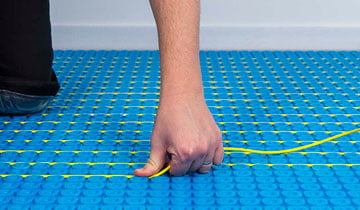18 min read
The top 5 electric underfloor heating brands to look out for in 2023
After the success of our ‘The top 5 electric underfloor heating brands for 2022?’ blog, we thought it would only be right to update it for 2023 and...

If you are in the market for an electric underfloor heating system for your next home renovation, then you have landed in the perfect place. We’ve written ‘7 top tips before buying electric underfloor heating’ to ensure you have all your ‘ducks in row’ before parting with any of your hard-earned cash.
In this blog, we’ll cover everything from the most suitable electric underfloor heating system for your project to who should install it. If you are looking for information about the running costs, head over to ‘10 common questions answered about electric underfloor heating’ because we’ve covered it in the first question.
This article takes less than five minutes to read but if you’d prefer to talk to one of the team, you can! You can find out how on our contact page.
You might be asking yourself ‘why does this matter?’, but it is one of the key things to know which will ultimately help boost the performance of your electric underfloor heating system.
Fundamentally, the type of subfloor that you have will depict what type of insulation board you need. For example, for concrete and screed subfloors, we recommend uncoated insulation boards and for timber substrates, there’s coated insulation boards.
I bet you are thinking ‘do I really need insulation board?’. But the simple answer is yes if you are looking for a high efficiency system with the lowest possible running costs. Not including insulation board will mean that the system will take longer to reach your desired temperature which will cost you more money to run.
To find out more about this very subject, read ‘Why removing insulation board from underfloor heating is costing homeowners’.
When it comes to what thickness of insulation board to choose, we recommend at least a 10mm board. However, if this is still a little too much, go with a 6mm board but it won’t be as efficient as the thicker alternative.
The type of electric underfloor heating system you choose will be heavily dependant on the floor finish you plan to have and how well insulated the room is.
Consider a heat loss calculation
When deciding what heating output you need, getting a heat loss calculation would be a good investment. If you don’t install the correctly sized system, it will be less efficient which can result in a longer time for the room to reach the desired temperature and the system costing more to run.
By completing a heat loss calculation you’ll know the correct sized system required to heat to your desired room temperature. This may even result in fewer cables and less power required to stay toasty, which is better for the environment and your bank balance.
Tile or stone floor finishes
Either a heating and decoupling system (ThermoSphere Membrane) or a pre-spaced mesh mat system (ThermoSphere Mesh).
A heating and decoupling system is designed to prevent cracking, lifting and delamination of tiled floors. It is a decoupling layer which allows the tiled surface to move independently from the subfloor. It has waterproofing properties too which makes it ideal for wet room projects.
This type of system also allows for different heating outputs by changing the spacing of the heating cable. For example, using wider spacing creates a lower heat output which is ideal for well-insulated rooms.
A pre-spaced mesh system has a heating cable already attached to a mesh mat at regular intervals and there are a variety of outputs available. The higher the wattage, the faster the heat-up time. For example, 200W/m2 is perfect for high demand rooms like conservatories. 150W/m2 is a great primary heat source for well insulated rooms and 100W/m2 is usually for floor warming only.
Wood, Carpet or Vinyl floors
A foil electric underfloor heating system works perfectly with floating floor finishes. They are designed to not overheat soft floor finishes and can be installed without the use of adhesives. These systems provide great thermal conductivity and fast heat up times because the heating cable is wrapped by two layers of foil which is an ideal thermal conductor.
If carpet is going to be your floor finish, there are things such as tog rating to consider. The absolute maximum tog rating to use is 2.5 because anything more will cause the underfloor heating system to not work as it should. You can read all about it in our blog ‘Can you use electric underfloor heating under carpet?’.
If a wooden floor finish is more your thing, we recommend reading ‘The best underfloor heating for wooden floors’ which contains tips, build-ups and more.
Any floor finishes
If your project is a new build or extension project, an in-screed system would work well because the heating cable can easily be installed in the screed layer in the building phase and can be used with any floor finish. This type of system is ideal for rooms that are in almost constant use as they have longer heat up and cool down times.
In-screed electric heating systems will take longer to install compared with electric underfloor heating mats.
This is the simple, yet important calculation you need to use when trying to work out how much underfloor heating you need for your project:
Floor Area (m2) – Area taken up by fixed units (m2) = Total Underfloor Heating (m2)
What are fixed units?
Let’s take your everyday bathroom as an example. The fixed units will be the bathtub, sink and toilet. Fixed units along with any type of flat-bottomed furniture like sofas and bookcases will restrict the airflow to the floor and in turn cause ‘thermal blocking’. This can result in the heating cable overheating causing damage to the floor above.
So, always calculate for fixed units and flat-bottomed furniture when working out how much electric underfloor heating you need.
When installing ThermoSphere Mesh or Membrane systems, it is vital to ensure that the heating cable is completely covered in tile adhesive. The adhesive layer acts as a 'heat sink' to conduct heat away from the cables and into the floor and room. Some installers like to cover the cable with a layer of self-levelling compound before tiling. This protects the heating cables, ensuring no air gaps, and gives them a nice level, flat surface to tile on.
If you're having a mesh or membrane system under a floor finish other than tile or stone, the heating cables must be covered with a 10mm deep layer of flexible self-levelling compound to protect the cable and dissipate the heat. This will make sure your new underfloor heating system works as efficiently as designed and lasts a lifetime.
The calculation used will depend on the brand of self-levelling, but for illustrative purposes, this is the calculation we use to make sure our customers have enough to cover their floor area.
(Floor area (m2) x 1.8 x Depth (mm)) / 25 = The number of bags needed
There’s nothing worse than having a thermostat that just feels too complicated to use or doesn’t do what you want it to. That’s why it’s important to pick a thermostat that suits how you want to control your heating. If you don’t you won’t benefit as much and will have a slimmer chance to improve system efficiency and reduce energy bills. Below is a summary of the types of thermostats available. Just remember that a manual thermostat is not lot 20 compliant, which means it doesn't have any of the mandatory energy saving features and must not be used to control your main source of heat.
Manual thermostat: Ideal if you want something simple
If technology isn’t your thing and you only want to control a secondary source of heat such as tile warming, then this is for you.
Programmable thermostat: The most popular type
If you are eager to reduce your energy consumption, and make a positive dent to your heating bills, then this feature-packed thermostat is just the thing.
Smart thermostat: Perfect for controlling your heating from your phone
This has the most potential of any thermostat to help you to reduce the running cost of your electric underfloor heating system. Plus, easy control via your smart phone and your voice.
Dual Control: Conveniently control two heating appliances with one thermostat
Enjoy the total convenience of controlling electric underfloor heating and another heating appliance (towel bar, towel rail or mirror demister) with one easy-to-use thermostat.
For further information on thermostats, read ‘What is the best thermostat to use for underfloor heating?’ or ‘Do smart thermostats save you money?’
Advice from your local electrician is invaluable when it comes to any proposed electrical heating installation.
An electric underfloor heating system can use a large amount of current so check the total load of the system does not exceed the total load capacity of the electrical circuit.
If the load of the electric underfloor heating circuit exceeds the maximum load of the thermostat (16A) and you want to control it with one thermostat, then a suitably rated contactor/snubber needs to be installed.
You can work this out using the following calculation:
(Heated area (m2) x Wattage of cable (W/m2)) / 230 = Load (A)
Even if you are a competent DIYer you must get your Part P registered electrician to check this as well as making the final connections of your electric underfloor heating to the mains.
There’s no denying it, electric heating continues to rise in popularity. However, with that comes a huge range of systems that vary in price and quality.
When looking at different systems we recommend checking:
Heating cable quality
Some systems offer standard heating cable and others, offer better quality which protects the integrity of your installation. For example, all our heating cable features a twisted construction which means that there are far lower stresses on the conductors and therefore lower risk of damage.
Warranty
A comprehensive lifetime warranty that stays with the home rather than the individual is ideal. It means, when you come to sell your property, your buyers are still covered by the warranty. As always, we recommend that you check the small print too.
Customer Service
Just like when you look at reviews of holiday destinations, check out the reviews of the system and brand. Often rare, things can go wrong. From a faulty sensor probe to a cable being damaged during installation. So going with a reputable brand with top reviews from installers and homeowners is recommended.
If you have a question about buying, selling or installing electric underfloor heating, please contact one of the ThermoSphere team who will be happy to help.

18 min read
After the success of our ‘The top 5 electric underfloor heating brands for 2022?’ blog, we thought it would only be right to update it for 2023 and...

9 min read
In the UK we are becoming increasingly conscious of the rising cost of energy and the impact that heating our homes has on the environment. Electric...

9 min read
When you ask a group of people if electric underfloor heating can be used as a primary heat source, more often than not you’ll get a mix of...